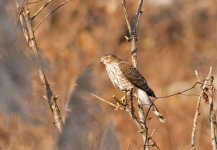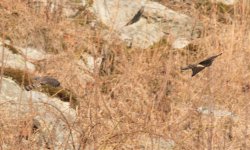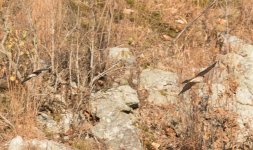Sharpie was hunting when a second hawk came in. They flew near each other for 10-15 seconds before disappearing into the woods. Didn't seem to aggressive towards each other. Thought the second bird was to large to be a female Sharpie. The perched bird is the trailing bird in the flight shots.
-
Welcome to BirdForum, the internet's largest birding community with thousands of members from all over the world. The forums are dedicated to wild birds, birding, binoculars and equipment and all that goes with it.
Please register for an account to take part in the discussions in the forum, post your pictures in the gallery and more.
You are using an out of date browser. It may not display this or other websites correctly.
You should upgrade or use an alternative browser.
You should upgrade or use an alternative browser.
2 sharpies or a sharpie and copper? (1 Viewer)
- Thread starter m.skalla
- Start date
More options
Who Replied?Nutcracker
Stop Brexit!
Both have nice square tail corners, not rounded off by shorter outermost tail feathers, so I'd say Sharp-shin for both :t:
A Cooper's would probably try to eat a Sharp-shin if it met it!
A Cooper's would probably try to eat a Sharp-shin if it met it!
birdmeister
Well-known member

Definitely both Sharp-shinned. Not bad pictures!
Deb Burhinus
Used to be well known! 😎

Two juveniles - nice images!
I think that the second bird is a Cooper's Hawk. It is a visibly more "bulky" bird than the 1st bird.
Wheeler comments on "An age-old problematic species for both adult and juvenile as concerns female Sharp-shinned Hawks" at Page 170 of his "Raptor's of Western North America" in the paragraph on "Similar Species" that "Cooper's Hawks are always longer in length, on average 3 in. (8 cm) and longer in wingspan, on average 4 in. (10 cm) .
And again in his Chapter on the Cooper's Hawk at page 184 in the paragraph on "similar species" he states categorically that "there is no overlap in size between the 2 species." He also notes that "With practice, both species can be separated on proportional differences without ever seeing plumage marks."
Also see the Chart below of the respective sizes of Cooper's Hawks and Sharp-shinned Hawks from the Canadian Peregrine Association: Note the difference in the weights of a male Cooper's Hawk and a female Sharp-shinned Hawk. (Scroll down to the chart.)
http://www.peregrine-foundation.ca/raptors/Coopers.html
Bob
Wheeler comments on "An age-old problematic species for both adult and juvenile as concerns female Sharp-shinned Hawks" at Page 170 of his "Raptor's of Western North America" in the paragraph on "Similar Species" that "Cooper's Hawks are always longer in length, on average 3 in. (8 cm) and longer in wingspan, on average 4 in. (10 cm) .
And again in his Chapter on the Cooper's Hawk at page 184 in the paragraph on "similar species" he states categorically that "there is no overlap in size between the 2 species." He also notes that "With practice, both species can be separated on proportional differences without ever seeing plumage marks."
Also see the Chart below of the respective sizes of Cooper's Hawks and Sharp-shinned Hawks from the Canadian Peregrine Association: Note the difference in the weights of a male Cooper's Hawk and a female Sharp-shinned Hawk. (Scroll down to the chart.)
http://www.peregrine-foundation.ca/raptors/Coopers.html
Bob
Last edited:
Deb Burhinus
Used to be well known! 😎

I think that the second bird is a Cooper's Hawk. It is a visibly more "bulky" bird than the 1st.
I put that down to perspective (notwithstanding the OPs obs) the difference could be also down to sexual dimorphism? and/or even a full crop./belly.?
In the third image (where the trailing bird is much further away than the one leading), the leading bird shows a comparatively short tail, a heavily streaked lower belly extending onto the flanks contrasting with the white vent and utc’s. favoring Sharpie imo.
In all images, as Nutcracker pointed out, the outer tail feathers don’t appear noticeably shorter than the inner, resulting in a neatly square cornered tail.
scoll down for images of juveniles in flight
http://www.mpnature.com/birds/species/COHA-SSHA.html
Last edited:
Jean FRANCOIS
Well-known member
For me too.Definitely both Sharp-shinned. Not bad pictures!
Jean
I put that down to perspective (notwithstanding the OPs obs) the difference could be also down to sexual dimorphism? and/or even a full crop./belly.?
In the third image (where the trailing bird is much further away than the one leading), the leading bird shows a comparatively short tail, a heavily streaked lower belly extending onto the flanks contrasting with the white vent and utc’s. favoring Sharpie imo.
In all images, as Nutcracker pointed out, the outer tail feathers don’t appear noticeably shorter than the inner, resulting in a neatly square cornered tail.
scoll down for images of juveniles in flight
http://www.mpnature.com/birds/species/COHA-SSHA.html
Thank you for that link from mpnature. Every little bit helps!
I respectfully disagree with your conclusion. The second bird still looks like a Cooper's Hawk to me. I think the birds are close enough to each other to make that determination. The smaller Sharp-shin to the rear appears to be the aggressor in chasing the front bird. I have seen this aggressive behavior by Sharpys on a number of occasions when visiting Hawk Mountain in Penna during the migration season.
I live in Northeastern Pennsylvania where both of these species are very common. Over the years I have often seen both species in the same day. I have even seen them from my deck within minutes of each other in the branches of the forest that borders my house.
As Brian Wheeler says, "With practice, both species can be separated on proportional differences without ever seeing plumage marks" and that is what I am basing my identification on.
As an example I have seen a male Sharp-shin on my lawn below my deck: It was in spring and it was as small as a Blue Jay maybe even a bit smaller. I still regret not having my camera with me then. According to Wheeler Female Sharp-shins assume all the nesting duties and the Males hunt. (see p169 Western Edition)
On another unforgettable occasion I was watching a female Sharp-shin (again, based on size) in the branches of a Silver Maple tree off my deck on an evening in June. It flew away and very shortly after it left a large Cooper's Hawk flew into the branches of the same tree perching about 10 feet above where the Sharp-shin had been. There was no mistaking the size difference. The Cooper's Hawk was bigger.
Bob
PS: I forgot another encounter with what I am pretty sure was a male Cooper's Hawk that I had on a spring morning in May 3 or 4 years ago when I was at my local bank cashing a check at the outdoor kiosks. A hawk flew down into the parking lot in front of me and captured a European Starling. Since the female Sharp-shin according to Wheeler always stays with the nest and it was too large to be a male Sharp-shin I concluded that it was a male Cooper's Hawk because it was not unusually big. Business came to a standstill while the customers got out of their cars to take pictures. And again I did not have my camera!
Last edited:
Deb Burhinus
Used to be well known! 😎

I respectfully disagree with your conclusion.
As you have every right to
pbjosh
missing the neotropics

Just to chime in:
-The perched bird and the second bird in the flight shots is a Sharpie for me based on structure, bill size, eye placement and size, leg thickness, and chest marking.
-The leading bird in flight also looks like a Sharpie to me based on chest / belly marking, tail proportions, and visible legs.
-The perched bird and the second bird in the flight shots is a Sharpie for me based on structure, bill size, eye placement and size, leg thickness, and chest marking.
-The leading bird in flight also looks like a Sharpie to me based on chest / belly marking, tail proportions, and visible legs.
Assume you saw them in the field and did not have the photographs to mull over and you were required to identify them while they were in flight. What would your identifications be? Remember Wheeler's comment in Post 8 above that "With practice, both species can be separated on proportional differences without ever seeing plumage marks."
Bob
Bob
Last edited:

without otherwise taking a stand on the id of the birds, there is one thing I have a problem with: it is that you talk about size almost exclusively when comparing the birds and that is not what is meant by the quote from Wheeler. Proportions are about how long the tail is relative to the width of the wings etc. So which proportions make you think that one is a coop?Remember Wheeler's comment in Post 8 above that "With practice, both species can be separated on proportional differences without ever seeing plumage marks.
Niels
Users who are viewing this thread
Total: 2 (members: 0, guests: 2)






